US bonds collapse, market crisis: Will the US financial system usher in a "moment of life and death"?

Reprinted from panewslab
04/09/2025·1MSource: Cailianshe
Author: Xiaoxiang
After our article mentioned in the morning of the day that the "trillion dollar US bond mine" (counter transaction closing position) was completely detonated, the selling of US bonds further intensified during the Asian session on Wednesday...
Market data shows that the yield on the 30-year U.S. Treasury has soared sharply and “breaking 5”, and soared 25 basis points to 5.010% in the day, setting a record high since the end of 2023.
The 10-year U.S. Treasury yield, known as the "anchor of global asset pricing", rose 21 basis points to 4.503%.
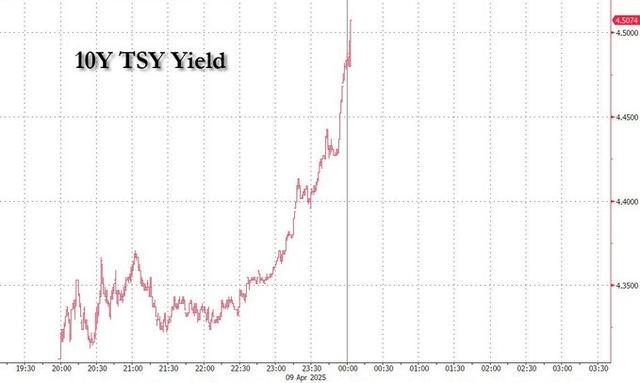
According to Jim Bianco, founder of the well-known research institution Bianco Research, the 30-year U.S. Treasury yield has risen by 56 basis points in just under three trading days. The last time the yield rose so much in 3 days was on January 7, 1982. But you should know that the yield on US Treasury was as high as 14% at that time (56 basis points were nothing at that time). Bianco said that this historic market was obviously caused by forced liquidation.
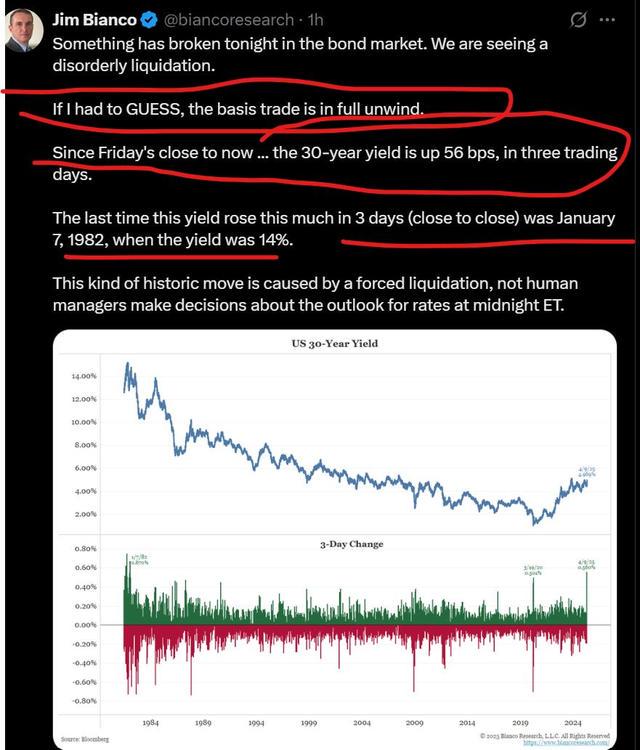
It can be said that this round of US Treasury plunge has completely broken away from the normal market volatility. Industry insiders have completely turned to two main speculations: ① How big is the impact of the US bond fund trading explosion? ② Are there really overseas "creditors" selling U.S. bonds?
Regarding the topic of US Treasury Fund Trading Explosion, we have fully explained it in the article on the morning of the day, and investors can read it themselves.
The well-known financial blog website Zerohedge also summarizes the context in which things may need to be careful about evolution in the future:
①The trillion-dollar US Treasury base transaction is breaking out, and countless funds and banks may be closing their positions;
②The liquidity in the system is far from enough;
③ The shock wave of insufficient liquidity may sweep all markets, leading to stock market plunges (liquidation panic), bond collapse (return-continuous protection), and foreign exchange risk aversion (the yen soars... and at some point, the turning point will come and the US dollar will be severely short);
④ Investors may encounter key liquidity exhaustion events today and tomorrow (the 10-year U.S. Treasury auction on Wednesday, followed by the 30-year U.S. Treasury auction on Thursday). If there is not enough liquidity in the system, we may experience informal bid failures - yes, although it is impossible to fail - the primary dealer who has the obligation to purchase all the obligations of failing to auction Treasury bonds to prevent abortion will provide a bottom-up, but if the allocation ratio of primary dealers is as high as 40% or 50%, it is almost equivalent to the auction failure.
Zerohedge believes that the results of two U.S. bond bidding auctions in the next 48 hours and whether the Federal Reserve will intervene in urgently may be the most important moment in the fate of the financial system in modern American history.
Nomura interest rate trader Ryan Plantz also warned in an internal memorandum that "in the Treasury bond sector, swap spreads and basis trading are melting. The U.S. Treasury market is undergoing large-scale closing positions that have not been seen in a career, and a liquidity vacuum has formed."
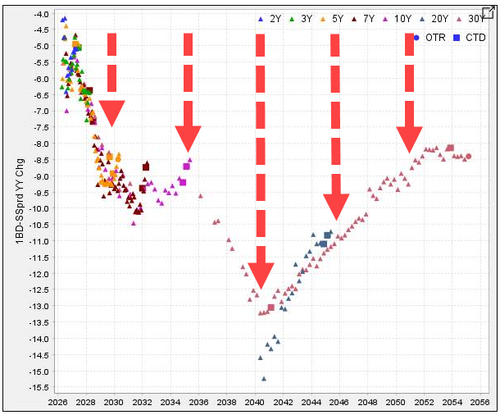
According to Plantz, the Fed must step in now, and while Powell may be reluctant to show that he is providing a bailout for Trump’s trade war, he may have no choice. Plantz notes:
The Trump administration’s so-called “silent mode” is taking effect – they allow the market pain to spread. The U.S. government's tough stance on trading partners has triggered a strike from real buyers, which has caused panic and has put the U.S. bond market into a demand vacuum. The spectacular collapse of US bonds at the close of Tuesday made many practitioners (including myself) continue to question market rationality - the yield curve has sharply steeped the bear market, and various interest rate spreads, basis and other indicators collapsed completely.
The single-day fluctuations in asset swap spreads are amazing (note that this is a change within 24 hours), and it is at least one of the most violent volatility I have ever witnessed in my career. The current market has completely fallen into a liquidity vacuum:
Market dialogue quickly turned to intensive discussions about "when will the Federal Reserve take action to save the market." We stressed on Tuesday that unless the following signals appear: the pressure on financing in the repurchase market surges and banks raise large-scale financing through institutions such as Fannie Mai (similar to the situation during the banking crisis a few years ago), the current turmoil is still a matter of market sentiment and confidence - only by reaching these thresholds can the Fed "emergency rate cut" be put on the agenda.
However, we can feel that the next boot may be about to land. Recalling the core goal of quantitative easing in 2020 is to maintain market liquidity and functions. If the gap-like fluctuations like Tuesday reappear on Wednesday, measures such as enabling standing repurchase convenience (SRF) and terminating quantitative tightening (QT) may be quickly put on the table. I even mentioned "Twisted Operation" (OT) today. . . This is where we are currently in. But it should be clear that the financing market has not yet reached the critical point.
It is worth mentioning that according to the suggestions put forward by four scholars from the University of Chicago Anil Kashyap and former Federal Reserve Director Jeremy Stein in the Brookings Institution report last month, the Federal Reserve wants to solve the problem of US bond fund trading explosion, and adopting "held-style bond purchase" is a relatively better way of intervention, that is, selling equal amounts of Treasury bond futures contracts to hedge while purchasing Treasury bonds.
Currently, although the scale is as high as one trillion US dollars, the main positions in US Treasury base trading are actually concentrated in the hands of less than 10 hedge funds, represented by Millennium, Citadel, Balyasny, Poin72, ExodusPoint and Lighthouse. The industry expects their average leverage multiple to be 20 times. This also means that as long as the relevant basis transaction losses reach 5%, they may be wiped out and margin will be required.
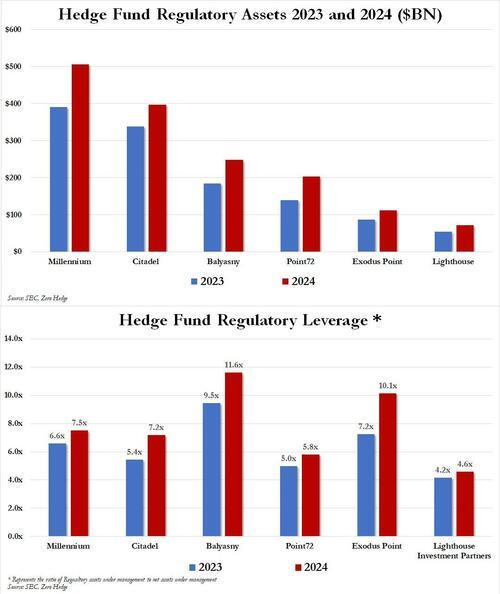
Note: The above figure shows the asset size comparison between the six major hedge funds year before and last year, and the following figure shows the leverage multiple comparison
In the past few years, the worst loss of related transactions was the early stage of the epidemic in March 2020. At that time, foreign central banks and bond funds that were facing redemption waves set off a "cash battle" and were forced to sell off their most liquid asset, U.S. Treasury bonds. This in turn has hit hedge funds that have built huge leveraged basis trading, nearly turning the chaotic Treasury bond sell-off into a catastrophic financial crisis. In the end, the Federal Reserve's "huge water injection action" of expanding its balance sheet by $1.6 trillion per month, which calmed the disaster.
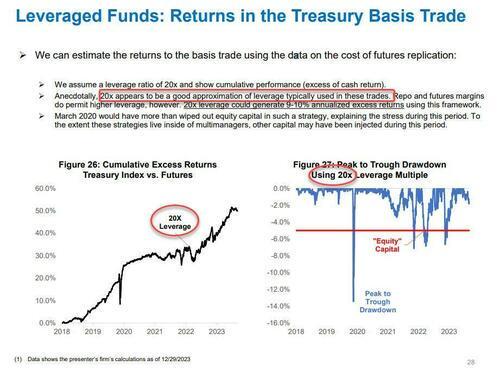
Note: The figure on the right shows the drawdown rate during the bond market selling wave in March 2020
Of course, what is more troubling at the moment is whether there are other forces selling besides the explosion of basis trading. More and more investment banking institutions are suspecting that Trump's reversal on tariff issues may trigger more U.S. overseas creditors to sell U.S. bonds.
"They may stop buying and boycotting U.S. bonds due to tariff frictions with China. Japan has the largest U.S. Treasury reserves, but China is also the second largest U.S. overseas creditor. What happens if this source of foreign demand shrinks or completely drys up?"
In this case, the Treasury Department will have to issue bonds at higher interest rates to make up for the losses: "Supply won't fall anytime soon, right? But you have to take action on demand."
At present, Japan, the largest "overseas creditor" of the United States, has stated that the recent U.S. bond sell-off was not done by it - Japanese Finance Minister Katsunobu Kato ruled out the possibility of using Japan's holdings of U.S. Treasury bonds as a bargaining chip to counter Trump's tariffs on Japanese imports.

